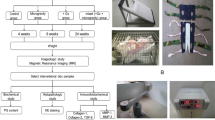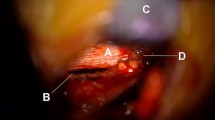Abstract
Purpose
Disc herniation risk is quadrupled following spaceflight. This study tested the hypothesis that swelling-induced disc height increases (comparable to those reported in spaceflight) stiffen the spine and elevate annular strain and nuclear pressure during forward bending.
Methods
Eight human lumbar motion segments were secured to custom-designed testing jigs and subjected to baseline flexion and compression and pure moment flexibility tests. Discs were then free-swelled in saline to varying supraphysiologic heights consistent with prolonged weightlessness and re-tested to assess biomechanical changes.
Results
Swelling-induced disc height changes correlated positively with intradiscal pressure (p < 0.01) and stiffening in flexion (p < 0.01), and negatively with flexion range of motion (p < 0.05). Swelling-induced increases in disc height also led to increased annular surface strain under combined flexion with compression. Disc wedge angle decreased with swelling (p < 0.05); this loss of wedge angle correlated with decreased flexion range of motion (R 2 = 0.94, p < 0.0001) and decreased stiffness fold change in extension (p < 0.05).
Conclusion
Swelling-induced increases in disc height decrease flexibility and increase annular strain and nuclear pressure during forward bending. These changes, in combination with the measured loss of lordotic curvature with disc swelling, may contribute toward increased herniation risk. This is consistent with clinical observations of increased disc herniation rates after microgravity exposure and may provide the basis for future countermeasure development.






Similar content being viewed by others
References
Johnston SL, Campbell MR, Scheuring R, Feiveson AH (2010) Risk of herniated nucleus pulposus among US astronauts. Aviat Space Environ Med 81:566–574. doi:10.3357/ASEM.2427.2010
Mirza SK, White AA III (1995) Anatomy of intervertebral disc and pathophysiology of herniated disc disease. J Clin Laser Med Surg 13:131–142. doi:10.1089/clm.1995.13.131
Simunic DI, Robertson PA, Broom ND (2004) Mechanically induced disruption of the healthy bovine intervertebral disc. Spine 29:972–978
Adams MA, Hutton WC (1982) Prolapsed intervertebral disc: a hyperflexion injury. Spine 7:184–191
Veres SP, Robertson PA, Broom ND (2009) The morphology of acute disc herniation: a clinically relevant model defining the role of flexion. Spine 34:2288–2296. doi:10.1097/BRS.0b013e3181a49d7e
Malko JA, Hutton WC, Fajman WA (1999) An in vivo magnetic resonance imaging study of changes in the volume (and fluid content) of the lumbar intervertebral discs during a simulated diurnal load cycle. Spine 24:1015–1022. doi:10.1097/00007632-199905150-00016
Adams MA, Dolan P, Hutton WC (1987) Diurnal variations in the stresses on the lumbar spine. Spine 12:130–137. doi:10.1097/00007632-198703000-00008
Wing PC, Tsang IK, Susak L, Gagnon F, Gagnon R, Potts JE (1991) Back pain and spinal changes in microgravity. Orthop Clin North Am 22:255–262
Cassidy JJ, Hiltner A, Baer E (1989) Hierarchical structure of the intervertebral disc. Connect Tissue Res 23:75–88. doi:10.3109/03008208909103905
Eguizabal J, Tufaga M, Scheer JK, Ames C, Lotz JC, Buckley JM (2010) Pure moment testing for spinal biomechanics applications: fixed versus sliding ring cable-driven test designs. J Biomech 43:1422–1425. doi:10.1016/j.jbiomech.2010.02.004
Thompson JP, Pearce RH, Schechter MT, Adams ME, Tsang IKY, Bishop PB (1990) Preliminary evaluation of a scheme for grading the gross morphology of the human intervertebral disc. Spine 15:411–415. doi:10.1097/00007632-199005000-00012
Farndale RW, Sayers CA, Barrett AJ (1982) A direct spectrophotometric microassay for sulfated glycosaminoglycans in cartilage cultures. Connect Tissue Res 9:247–248. doi:10.3109/03008208209160269
Harkness RD (1968) Mechanical properties of collagenous tissues. Treatise on Collagen, 2 (Part A). Academic Press, London
Hickey DS, Hukins DW (1980) Relation between the structure of the annulus fibrosus and the function and failure of the intervertebral disc. Spine 5:106–116
Dhillon N, Bass EC, Lotz JC (2001) Effect of frozen storage on the creep behavior of human intervertebral discs. Spine 26:883–888
Paul Brinckmann D (1986) Injury of the annulus fibrosus and disc protrusions: an in vitro investigation on human lumbar discs. Spine 11:149–153. doi:10.1097/00007632-198603000-00009
Stokes IA (1987) Surface strain on human intervertebral discs. J Orthop Res 5:348–355. doi:10.1016/0021-9290(86)90034-5
Shiraz-Adl A (1989) Strain in fibers of a lumbar disc: analysis of the role of lifting in producing disc prolapse. Spine 14:96–103
Yamamoto I, Panjabi MM, Crisco T, Oxland TOM (1989) Three-dimensional movements of the whole lumbar spine and lumbosacral joint. Spine 14:1256–1260. doi:10.1097/00007632-198911000-00020
Adams MA, McNally DS, Wagstaff J, Goodship AE (1993) Abnormal stress concentrations in lumbar intervertebral discs following damage to the vertebral bodies: a cause of disc failure? Eur Spine J 1:214–221. doi:10.1007/BF00298362
Steffen T, Baramki HG, Rubin R, Antoniou J, Aebi M (1998) Lumbar intradiscal pressure measured in the anterior and posterolateral annular regions during asymmetrical loading. Clin Biomech 13:495–505. doi:10.1016/S0268-0033(98)00039-4
Panagiotacopulos ND, Pope MH, Bloch R, Krag MH (1987) Water content in human intervertebral discs: part II. viscoelastic behavior. Spine 12:918–924
Hirsch C, Galante J (1967) Laboratory conditions for tensile tests in annulus fibrosus from human intervertebral discs. Acta Orthop Scandinav 38:148–162
Skaggs DL, Weidenbaum M, Ratcliffe A, Mow VC (1994) Regional variation in tensile properties and biochemical composition of the human lumbar anulus fibrosus. Spine 19:1310–1319. doi:10.1097/00007632-199406000-00002
Cao P, Kimura S, Macias BR, Ueno T, Watenpaugh DE, Hargens AR (2005) Exercise within lower body negative pressure partially counteracts lumbar spine deconditioning associated with 28-day bed rest. J Appl Physiol 99:39–44. doi:10.1152/japplphysiol.01400.2004
Belavý DL, Armbrecht G, Gast U, Richardson CA, Hides JA, Felsenberg D (2010) Countermeasures against lumbar spine deconditioning in prolonged bed rest: resistive exercise with and without whole body vibration. J Appl Physiol 109:1801–1811. doi:10.1097/BRS.0b013e3181cc93e8
Whitcome KK, Shapiro LJ, Lieberman DE (2007) Fetal load and the evolution of lumbar lordosis in bipedal hominins. Nature 450:1075–1078. doi:10.1038/nature06342
Adams MA, Hutton WC (1986) Has the lumbar spine a margin of safety in forward bending? Clin Biomech 1:3–6. doi:10.1016/0268-0033(86)90028-8
Belavý DL, Bansmann PM, Böhme G, Frings-Meuthen P, Heer M, Rittweger J, Zange J, Felsenberg D (2011) Changes in intervertebral disc morphology persist 5 mo after 21-day bed rest. J Appl Physiol 111:1304–1314. doi:10.1152/japplphysiol.00695.2011
Wilke HJ, Neef P, Caimi M, Hoogland T, Claes LE (1999) New in vivo measurements of pressures in the intervertebral disc in daily life. Spine 24:755–762. doi:10.1097/00007632-199904150-00005
Belavý DL, Ohshima H, Bareille MP, Rittweger J, Felsenberg D (2011) Limited effect of fly-wheel and spinal mobilization exercise countermeasures on lumbar spine deconditioning during 90d bed-rest in the Toulouse LTBR study. Acta Astronaut 69:406–419. doi:10.1016/j.actaastro.2011.05.015
Belavý DL, Armbrecht G, Felsenberg D (2012) Incomplete recovery of lumbar intervertebral discs 2 years after 60-day bed rest. Spine 37:1245–1251. doi:10.1097/BRS.0b013e3182354d84
Panjabi MM (1988) Biomechanical evaluation of spinal fixation devices: I. A conceptual framework. Spine 13:1129–1134
Acknowledgments
This work was supported by the National Aeronautics and Space Administration (NASA), Grants NNX10AM18G and NNX13AM89G.
Author information
Authors and Affiliations
Corresponding author
Ethics declarations
Conflict of interest
The authors do not have any financial relationship with the organization that sponsored the research (NASA), and have full control of all primary data that the journal is free to review if requested.
Rights and permissions
About this article
Cite this article
Laws, C.J., Berg-Johansen, B., Hargens, A.R. et al. The effect of simulated microgravity on lumbar spine biomechanics: an in vitro study. Eur Spine J 25, 2889–2897 (2016). https://doi.org/10.1007/s00586-015-4221-6
Received:
Revised:
Accepted:
Published:
Issue Date:
DOI: https://doi.org/10.1007/s00586-015-4221-6




